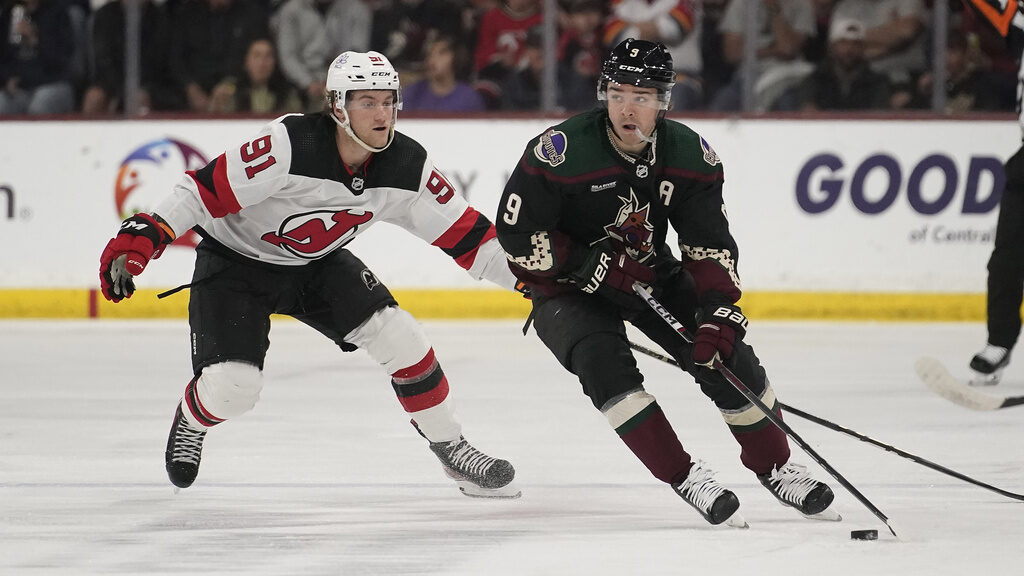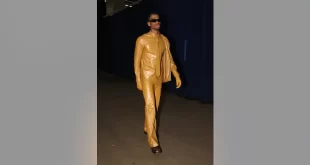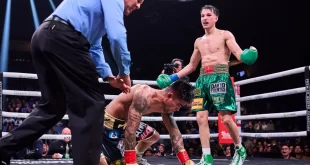PHOENIX—Kenny Hockey hotbed McGinley takes great satisfaction in having been among the first hockey players in Arizona in his generation. The current president of the Arizona High School Hockey Association, who was born in 1993, was three years old when the original Winnipeg Jets disbanded and became the Phoenix Coyotes, one of the major sports teams in the Valley.
There was a lot of doubt for many years following the NHL’s arrival in the Valley as to whether a winter sport like hockey could thrive in a dry environment. However, there are a number of reasons why hockey has expanded over the last 27 years, the most significant of which is the Coyotes’ accomplishment in leading the hockey revolution in Arizona.

It seems like Arizona hockey is going through a turbulent period right now. The 2023–24 Coyotes regular season came to an end on April 17 at Tempe’s 5,000-seat Mullet Arena. The team was renamed the Arizona Coyotes in 2014. The Coyotes were sold, and it was revealed the following day that they would be relocating to Salt Lake City as a result of the ownership’s inability to negotiate a long-term arena contract in the Valley. But an NHL team in Arizona has far-reaching effects that go far beyond the game.
The sport can flourish in such an unconventional environment, as seen by the ever expanding youth scene for both boys and girls, as well as the advancements achieved in college and minor league hockey.
The growth of youth hockey in the desert
There are currently 15 ice rinks in the state of Arizona, a sharp rise from the time the Coyotes moved to the area and the number in the Phoenix Metropolitan Area. As a result, young initiatives began to take shape. One such program is the Jr. Coyotes, which had its start in the early 2000s, around the time that Scottsdale’s Ice Den was constructed.
It goes without saying that as more rinks and hockey programs were accessible, more kids were exposed to the game. 4,949 athletes from Arizona were registered with USA Hockey for the 2002–03 season. The total number of players registered has increased to 9,716 after twenty years.
Mike DeAngelis, Director of Operations for the Arizona Jr. Coyotes, stated that “there are just more kids playing hockey now.” “The caliber of play is increasing, with young men participating in the NHL, professional hockey players, and Arizona college hockey players.”

“There was a pretty decent triple-A community going on, but not many kids playing hockey, compared to when I first got involved.” (Not) as many, and most definitely not the facilities, as there are currently. Thus, I can attest that in addition to the numbers increasing, the quality of play has also significantly increased.
More than just a notable increase in membership, Arizona’s youth hockey programs, such as the Jr. Coyotes, have experienced tremendous growth and progress over the years. Athletes in the program are receiving superior training and an opportunity to learn from experts thanks to the addition of multiple coaches with extensive hockey experience at different levels.
DeAngelis had a lengthy playing career of his own. Before starting a 14-year professional career that saw him play in leagues all over the world, mostly in Italy, including two seasons with the Phoenix Mustangs of the now-defunct West Coast Hockey League, the defenseman was a four-year contributor at the University of Minnesota Duluth from 1984 to 1988.
A few former NHL players, including Steve Sullivan, Zayne Michele, and Michael Grabber, are employed by the Jr. Coyotes.
According to DeAngelis, “I think our athletes’ and coaches’ levels have gone way up.” Many former NHL players and Coyotes players currently work as coaches in our program. Both the coaching and player levels have increased.
A cursory examination reveals that there has been an improvement in the caliber of athletes competing in Arizona. Numerous gifted hockey players have made their Arizona debuts since the Coyotes’ founding season, but none more prominent than Toronto Maple Leaf’s forward Auston Matthews. Although Matthews was born in San Ramon, California, his family relocated to Scottsdale a few months later, and it was in the Grand Canyon State that Matthews’ love of hockey was first sparked.
Prior to choosing to play in the United States Hockey League (USHL) and subsequently spending his draft year abroad in the Swiss National League, Matthews played hockey in Arizona up until the 16U age group. The Maple Leaf’s’ 2016 first-round selection of him signaled the start of an extraordinary, decorated career. Only three Arizona-born hockey players had ever played in the NHL before Matthews was drafted: defenseman Jim Brown, goalie Ty Conklin, and forward Sean Couturier.
Even though the 26-year-old has a long way to go in his playing career, his resume is already very strong. Having played in the NHL for six full seasons, Matthews has earned two Maurice “Rocket” Richard Trophies, four All-Star selections, and the title of league most valuable player for the 2021–2022 season. With 69 goals this season, he lead the NHL.
Matthews is not the only well-known Valley native to play professional hockey. The 21-year-old forward Matthew Knifes of the Maple Leaf’s appears to be a bright future for his team, while Josh Doan of the Coyotes, a former ASU player and son of Yotes great Shane Doan, was recently called up to the NHL and scored nine points in 11 games.
“(Matthews) has had incredible success in the hockey world,” DeAngelis remarked. “He is well known to all. For many children in the neighborhood of these youngsters, this year has been significant. (Knifes) most recently with the Toronto Maple Leaf’s.
Aside from Matthews, Arizona is home to several of the game’s best players, including center Tague Thompson of the Buffalo Sabers, winger Brady Tkachuk of the Ottawa Senators, and forward Matthew Tkachuk of the Florida Panthers. The Jr. Coyotes advanced to the title game of the prestigious Circle K Classic, an annual international junior competition hosted in Calgary, in January.

The junior hockey sector in Arizona still has room to grow, but because to the lack of playing fields throughout the state, it is still less accessible than outdoor sports like baseball and football. However, it’s crucial to recognize how far the Jr. Coyotes have come, giving young athletes in Arizona a competitive chance to finish their hockey careers at home. There is a need for it.
According to DeAngelis, “there aren’t many reasons anymore for kids to leave Arizona to find another level of youth hockey.” “When they’re ready, we want them to leave Arizona and join junior hockey.”
An expanding scene in high school
As president of the Arizona High School Hockey Association, McGinley hasn’t always been leading the league’s expansion; he played high school hockey himself, though in a much smaller league than there is now.
He started coaching locally as soon as he finished his four years of high school playing at Horizon High School. Despite the organization’s years of growth and change, McGinley has remained committed to the idea that high school hockey in Arizona should be a constructive environment where players can advance their skills.
“I like the less stressful atmosphere at high school,” McGinley remarked. Our approach is player- and family-centered, with the question “What is the best experience for our players?’ at the forefront of both.” It’s the quality of the experience that matters, not the level of hockey.
There has been a notable increase in registration for the group. There were 28–30 teams and roughly 450–500 players in 2013–14. The AHSHA is now in its 24th season, with 40 teams and over 770 participants.
According to McGinley, “our registration on May 15 of last year literally sold out in 20 minutes, if that.” It was sixty or seventy minutes the previous year, and three or four hours the year before that. Thus, you can tell which way it’s trending just by looking at it. I believe that a portion of that is due to the fact that high school hockey players are improving. As a result, that is really beneficial and encourages growth since it makes more children want to play.
Notwithstanding the surge in player engagement, the AHSHA continues to confront several obstacles, the most significant of which is player dispersion.

In Arizona, high school hockey is currently played at four different levels: Jr. Varsity, Division 1, Division 2, and Division 3. But when it comes to fielding teams, not all schools are made equal. Some schools, including Pinnacle High School in Phoenix and Notre Dame Prep in Scottsdale, have enough athletes to form full teams. However, this isn’t the case for most Arizonan institutions.
The population of the Valley is dispersed, with over five million people living in the 14,587 square mile Phoenix metropolitan area. As a result, most of the 130 schools that the AHSHA represents do not have nearly enough enrolled hockey players to field a full team. Thus, the organization created a workaround.
By completely fielding its registration, the AHSHA is able to manually assign players to teams. Although the procedure varies from year to year, in general, the organization uses data such as zip codes and school district boundaries to assign players in the area to play for the closest institution if a school does not have enough players for a full team.
As an example, consider Peoria’s Centennial High School, the 2024 AHSHA state winner. It is one of the only high school hockey teams in the West Valley, along with Glendale’s Mountain Ridge High School. With only two teams in close vicinity, there is a big umbrella from which both clubs can draw players, with an estimated 160 players in that area.
McGinley advised, “Just imagine it as a huge net that’s cast over the entire West Valley.” “We could divide the players into seven or eight teams, each with a different name from the school.” However, if you do that, there will be a mix of youngsters who have never played hockey before and one excellent player.
“In the end, as we have witnessed over the past 20 years, teams have not achieved any success. Some teams play with a roster of only 12 or 13 players, which complicates year-to-year transitions, budgeting, and organization. For a variety of reasons, we combined them together to create larger programs that would provide stability and success both on and off the ice.
Notwithstanding these difficulties, it is evident how far the AHSHA has progressed in such an unconventional hockey market. High school hockey was a hot commodity in the Valley even in its early years. According to McGinley, attendance at the Division 1 state championship at the Ice Den was consistently attended by 550 spectators as early as 2008.
“The line was around the building three to four hours before we started to sell tickets,” McGinley stated. 500–600 people were waiting in line. It was the weirdest thing I’ve ever seen when they brought lunch and pizza.

Therefore, the AHSHA made a major step in 2012 and relocated its championship to Desert Diamond Arena in Glendale, which was once the Coyotes’ home. Even though the event drew close to 1,500 attendees, the organizers decided to return to Scottsdale since the vibe in the 17,000-seat arena just wasn’t the same.
The AHSHA was essentially in a holding pattern because the championship was too large for the Ice Den but too small for a typical NHL arena. After two years of hosting the game at Tempe’s now-demolished Oceanside Ice Arena, the Coyotes moved to Mullet Arena in 2022, a 5,000-seat venue on the Arizona State University campus in Tempe. And coincidentally, Oceanside’s manager, Adam Mims, took a job at the new rink, providing the AHSHA with a crucial link.
McGinley realized he had finally found the one at that moment. He planned to meet with leadership to talk about a possible cooperation as soon as Mullet Arena opened. The tournament relocated to the arena in 2023, and the event immediately had a more polished, businesslike appearance.
McGinley remarked, “It seems like we play there more big-league than we actually are.” The ability to turn on all the lights, cameras, bells, whistles, and other features “gives a way higher production of the game than what our level actually is,” the participant said.
Mullet Arena management believed they had made the right choice in permitting the 2023 AHSHA State Championship to be held in their facility after seeing the boisterous atmosphere of the competition. Approximately 2,000 people attended the 2024 championship, which included Centennial and Notre Dame Prep. This was about half of the venue’s capacity, but the energy of the packed, boisterous arena was evident.
The rise of hockey in Arizona is correlated with an increase in the number of schools offering the sport, suggesting that high school hockey’s potential for growth is virtually endless. But regardless of how well-liked the sport is in a given year, the AHSHA’s objective is always the same: to assist the players in improving their skills. McGinley stated, “The focus is solely on hockey ability.” In addition to building the greatest hockey leagues we can, we also want to advance as many teams as we can so that no team finishes 0–20. Our goal is for our players to grow. If there are 770 participants, our goal is for 770 of them to finish the season as better hockey players than when they started.
Expanding women’s hockey
Prior to the 2014 Winter Olympics in Sochi, Russia, Arizona Kachinas president Lyndsey Fry was given the opportunity of a lifetime.
During her fourth year at Harvard, the Chandler native discovered that she was picked to represent the United States’ women’s hockey team at the Games, a credit to her tireless training and undying passion to the sport. While the Americans fell just short of earning the gold medal as they were defeated by rival Canada in the championship game, Fry had accomplished something that no hockey player from Arizona ever had before.
“Representing your country is incredible, but I found it extremely meaningful to represent my state,” Fry remarked. “I was acutely aware that, should I be selected for that squad, I would become the first Arizonan hockey player, male or female, to accomplish that feat. That’s why it was special to make that team. However, because I was a little girl from the Arizona desert, I also frequently tell people that telling my family that I had made it was my favorite part of the Olympics.
A year later, Fry’s time at Harvard came to an end, but she realized she couldn’t give up on the sport she loved entirely, so she decided to start instructing ladies hockey, especially in places like Alabama and New Mexico where the sport wasn’t very popular. In order to achieve this, she founded Lyndsey Fry Hockey, her own organization ten years ago, with the goal of encouraging young girls to play the sport.
At that same period, Fry started hosting hockey camps in the Phoenix metro area, where she had played as a child. She was able to fortify her connections with Valley rinks as a result, which was helpful when she started working for the Coyotes not long after returning to Arizona from Harvard.
Along with former Coyotes Senior Director of Hockey Development Matt Short, who passed away in 2021 after a battle with liver cancer, Fry got to work right away, quickly establishing the Arizona Kachinas, an exclusive girls hockey program in Arizona. Fry was hired by the Coyotes as a full-time employee in 2018 as a hockey ambassador and advisor to the president/CEO.
However, the truth is that Fry faced difficulties in her efforts to expand women’s hockey in an unexplored market. Only 377 female hockey players from Arizona were registered with USA Hockey in the 2002–03 season. Even if it increased to 1,060 in 2022–2023—that still only accounted for a small portion of the state’s total player population of 9,716. Consequently, the biggest challenge Fry had in the early years of the Kachinas was just getting word out to families about the availability of girls hockey.
“Most of the time, parents just need to be informed about what (hockey) is and what their daughters’ opportunities are,” stated Fry. “Because people still think, ‘Wait, hockey is played in Arizona? And girls hockey exists in Arizona? We must so keep fighting through it, but once we get them outside, it should not be too difficult to keep them there.
The Industry Growth Fund, a 2013 joint effort between the NHL and NHLPA where owners and players deposit money into a pool that goes to growing hockey in North America by helping franchises create new programs, has tremendously benefited the Coyotes’ women’s hockey programs. The Small Fry’s, a program that helps introduce young girls to hockey, and the Kachinas were created as a result of the Coyotes receiving their first girls’ hockey grant in 2017.
The number of teams in the state increased from four to nine with help from the NHL and the acquisition of two already-existing girls’ hockey programs in Arizona. After four years, Arizona now boasts sixteen teams playing women’s hockey, all connected to the Kachinas. The Valley now has teams for females of all ages.
Although they don’t play hockey in a hockey-heavy area, the Coyotes’ achievements in women’s hockey served as a model for other teams. The significance of the Coyotes’ program on women’s hockey was demonstrated by the fact that other NHL teams, such as the Chicago Blackhawks, Carolina Hurricanes, and Washington Capitals, all replicated their own.
In Arizona, hockey has expanded in a number of areas, including women’s hockey, and Fry thinks the current surge in the sport’s popularity is just the beginning. Of course, Fry’s primary focus is women’s hockey, but she is hopeful that the sport will continue to grow in the Grand Canyon State.
“Every level of girls’ hockey is available right now,” Fry stated. “You can play house recreation if that’s what you want to do. You can play A hockey if that’s what you want to do. We have females that have committed to the ACHA and NCAA at every level. I had to go away to pursue chances in Colorado. Children are no longer required to go. In my opinion, our goal was to develop a comprehensive program that would benefit the greatest number of females.

“Regardless of what happens, I’m optimistic about the future of hockey in Arizona because I believe the sport has so much momentum going into the next 25–30 years and there are so many passionate people here.”
There is yet hope.
There was a lot of concern about the future of hockey in the Valley following the Coyotes’ sudden relocation. However, a few months after the change was made public, Fry led a group of stakeholders in presenting a strategy to keep the sport growing in Arizona.
She announced on April 25 the founding of the Matt Schott Arizona Hockey Legacy Foundation, a nonprofit with the mission of assisting young players in the Phoenix metropolitan area who play hockey at all levels. Fry will serve as the foundation’s chair, but Grabber, Jason Demers, and Greg Adams—all of whom were Coyotes players during their professional careers—are among the other well-known hockey figures engaged.
Over the next five to ten years, the foundation hopes to build an endowment of $10,000,000 to support young hockey, which may be costly to play and manage. This news was made soon after Coyotes owner Alex Merely promised at a recent press conference to keep helping young hockey players in the Grand Canyon State.
Even with the loss of its NHL club, Arizona clearly developed a sizable enough hockey fan base to warrant quick action to protect the game. The NHL has been given a five-year window to start construction on a new arena, but there are no guarantees that the league will return. Nevertheless, the sport’s expansion in the desert can continue.
Article Source Cronkite news



